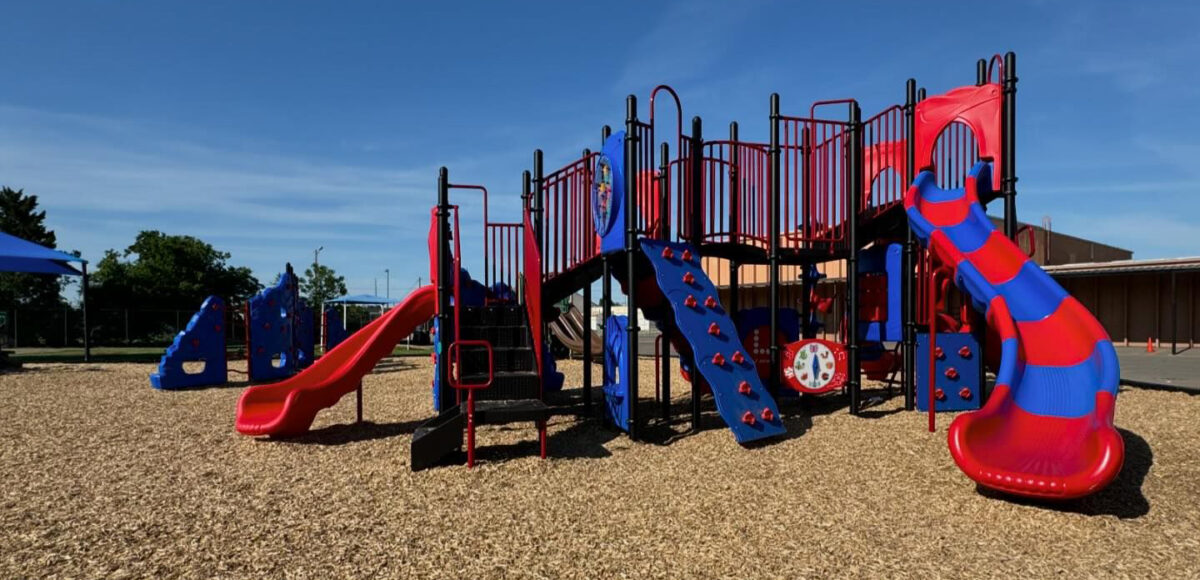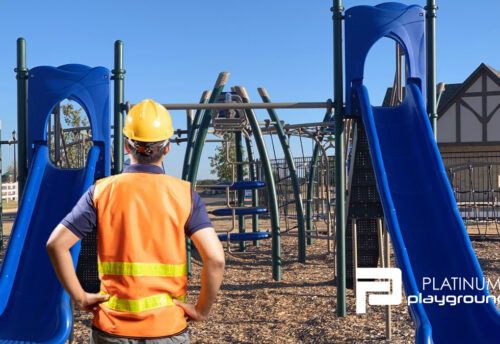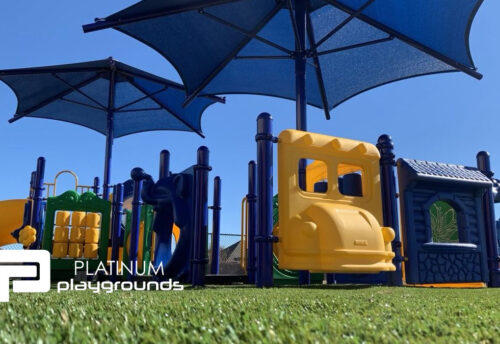
Making School Playgrounds Fun
Truly great school playgrounds are more than just a collection of swings and slides. They’re an immersive environment that encourages children to explore, interact, and engage in ways that promote their physical, social, and cognitive development. For children aged 5-11, an engaging playground design needs to stimulate curiosity, challenge growing bodies, and nurture social interaction—all while keeping safety in mind. So, what exactly makes for an engaging playground design? Let’s dive into the key elements that create a play space kids will love and come back to day after day.
Age-Appropriate School Playgrounds: Keep Them Engaged and Growing
Children in the 5-11 age group are at a stage where they are not only developing physically but also socially and cognitively. This is the age where they love testing their limits, pushing their boundaries, and learning new skills. A well-designed playground should offer varying degrees of physical challenges that cater to their growing abilities.
Climbing Structures:
At this age, children love to climb! Climbing equipment like rock walls, ladders, and monkey bars helps to build upper body strength, balance, and coordination. More advanced climbing challenges, such as rope courses or interconnected platforms, give children the chance to test their problem-solving abilities and spatial awareness while staying engaged in play.
Slides:
Slides are a timeless playground staple, but not all slides are the same. Multi-level, twisting, or tunnel slides add a sense of adventure and thrill, keeping children excited about their next trip down. Slides that are part of a larger structure can also encourage more imaginative play as children imagine different scenarios while climbing, sliding, or racing their friends.
Swinging and Spinning:
Swings and spinning equipment help develop a child’s sense of balance and coordination while providing them with the joy of flying through the air. Large group swings or merry-go-round-style equipment also encourage teamwork and cooperative play, fostering social development.
Physical Skill Development Elements:
- Rope Climbs and Cargo Nets: Encourage upper body strength and balance.
- Balance Beams or Wobble Bridges: Promote coordination and core stability.
- Obstacle Courses: Multi-functional play that challenges both physical agility and problem-solving.
Learn more about School Playgrounds and other markets served by Platinum Playgrounds.
School Playgrounds Stimulate Imagination and Creativity
For a playground to truly engage children, it needs to stimulate their imagination. Children between 5 and 11 are incredibly creative and often use playtime as a way to create stories, explore roles, and experiment with their own ideas. Play equipment that offers interactive or themed elements encourages them to step into different worlds during play, enhancing cognitive development through creative exploration.
Interactive Panels and Playboards:
Features like sensory play panels, musical instruments, or puzzle boards built into playground structures stimulate the mind and encourage exploration. Whether it’s tapping out a rhythm on a drum panel or using gears to complete a sequence, these elements give kids a chance to engage with their surroundings in a way that’s both educational and fun.
Theme-Based Structures:
Pirate ships, castles, space stations—when playground equipment reflects popular themes, it invites children to create their own narratives. A playground becomes a stage for imaginative adventures, where kids can collaborate, solve problems, and role-play together.
Loose Parts for Building:
Playgrounds that incorporate elements kids can manipulate—like blocks, sticks, or modular elements—encourage them to build, rearrange, and invent during their play. This kind of open-ended play boosts creativity and innovation while helping children develop critical thinking skills.
Examples of Creative and Imaginative Play Elements for School Playgrounds:
- Play Panels: Tactile activities like steering wheels, speaking tubes, or mazes.
- Themed Play Structures: Castles, spaceships, or animal shapes that inspire role play.
- Modular Elements: Movable pieces like large blocks or sand pits for constructing new play spaces.
School Playgrounds Foster Friendships
A great playground isn’t just about individual play; it’s also a space where children learn how to interact with others, share, take turns, and work together. Playtime is a critical opportunity for developing social skills, and playground equipment that encourages group activities or cooperative challenges fosters these essential life skills.
Inclusive Play Structures:
Multi-user swings, seesaws, or merry-go-rounds encourage children to work together to create motion. These shared activities help kids develop communication, empathy, and teamwork as they figure out how to swing or spin together.
Group Challenges:
Elements like balance beams, rope courses, or obstacle structures that can accommodate several children at once create a sense of community as kids encourage each other to succeed. These features promote cooperative problem-solving and healthy competition, helping children build confidence and resilience in a group setting.
Spaces for Quiet and Group Play:
Not every child wants to run, jump, or climb all the time. Some may need spaces for quiet reflection or smaller group play. Incorporating elements like shaded seating areas or small hideaways in the design allows children to choose how they want to engage, whether they prefer an energetic game of tag or a quiet chat with friends.
Ways to Promote Social Interaction in School Playgrounds:
- Multi-user Equipment: Group swings, seesaws, or large spinning platforms.
- Obstacle Courses: Where children can race or challenge each other to complete tasks together.
- Collaborative Games: Elements that require multiple kids to engage, like a group swing or puzzle panel.
Sensory Play and Inclusivity: Engaging All Children
A truly engaging playground considers the sensory needs of all children. Sensory play is especially important for children who may have developmental differences or sensory processing issues. Providing inclusive equipment that appeals to a variety of senses (touch, sight, sound) ensures that every child has the opportunity to participate in meaningful and enriching play.
Sensory Panels:
Incorporating elements like textured panels, sand or water play, and musical instruments helps engage children with different sensory needs. These features can help calm children who may become overwhelmed by more active play and give them a chance to participate at their own pace.
Accessible Play Areas in School Playgrounds:
Ensuring that playgrounds are inclusive is key to fostering a sense of belonging. Equipment designed for children of all abilities, such as ramps for wheelchair access or ground-level play features, ensures that every child can join in the fun.
Elements of Inclusive Sensory Play:
- Musical Instruments: Drums, chimes, or bells that engage auditory senses.
- Textured Panels: Surfaces with different textures for tactile exploration.
- Wheelchair-Accessible Ramps and Swings: Ensuring no child is left out of the fun.
Variety in School Playgrounds: Keeping Play Fresh and Exciting
An engaging playground design should offer variety. Children in the 5-11 age range are constantly developing, and their play needs change over time. A well-designed playground will feature a variety of elements that cater to different types of play—whether it’s active, imaginative, cooperative, or quiet. This variety keeps children engaged and excited to return to the playground, ensuring that they don’t grow bored after repeated visits.
Rotating Play Elements:
Incorporating elements like modular play structures or equipment that can be swapped or rearranged gives the playground a sense of freshness, encouraging repeat visits. Children will keep coming back if they know there’s always something new to explore.
Accessible Play Areas Are a Must for School Playgrounds:
Ensuring that playgrounds are inclusive is key to fostering a sense of belonging. Equipment designed for children of all abilities, such as ramps for wheelchair access or ground-level play features, ensures that every child can join in the fun.
Elements to Incorporate for Variety:
- Physical Play Structures: Climbing, sliding, spinning, and swinging elements.
- Imaginative Play Areas: Themed structures and interactive panels.
- Social and Group Play Equipment: Multi-user swings, collaborative games, and large play platforms.
By incorporating these elements, your school playground will not only be fun but developmentally appropriate for children aged 5-11. When you choose Platinum Playgrounds, you’re not just investing in equipment; you’re creating an environment where children can grow, learn, and play in a way that’s safe, stimulating, and inclusive. Our thoughtfully designed playgrounds are built to engage minds and bodies, ensuring that every child finds joy in the power of play.
Find out other important considerations when selecting your school playground, read “Building a Safe and Fun School Playground: A Guide for Decision-Makers”.


